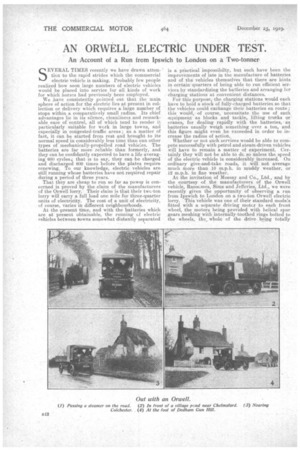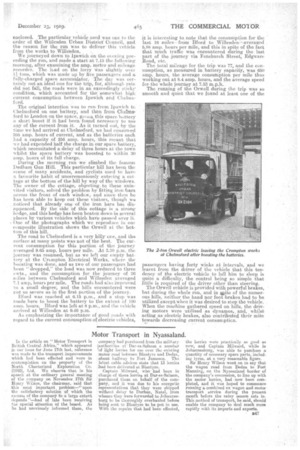AN ORWELL ELECTRIC UNDER TEST.
Page 20

Page 21

If you've noticed an error in this article please click here to report it so we can fix it.
An Account of a Run from Ipswich to London on a Two-tonner
SEVERAL TIMES recently we have drawn attention to the rapid strides which the commercial electric vehicle is making. Probably few people realized how soon large numbers of electric vehicles would be placed into service for all kinds of work for which horses had previously been employed. We lave consistently pointed out that the main sphere of action for the electric lies at present in collection or delivery which requires a, large number of stops within a comparatively small radius. Its chief advantages lic in its silence, cleanliness and remarkable ease of control, all of which tend to render it .particularly suitable for work in large towns, and especially in congested-traffic areas; as a matter of fact, it can be started from rest and brought-to its normal speed in considerably less time than can other types of mechanically-propelled road vehicles. The batteries are far more reliable than formerly, and they can be confidently expected to have a life averaging 600 cycles ,; that is to say, they can be charged and discharged 600 times 'before the plates require renewing. To our knowledge, electric vehicles are still running whose batteries have not required repair during a period of three years.
That they are cheap to run so far as power is concerned is proved by the claim of the manufacturers of the Orwell lorry. Their claim is that their two-ton lorry will carry a full load one mile for three-quarter units of electricity. The cost of a unit of electricity, of course, varies in different neighbourhoods. At the 'present time, and with the batteries which are at present obtainable, the running (.4 electric vehicles between towns somewhat distantly separated is a practieal impossibilty, but such have been the improvements of late in the manufacture of batteries and of the vehicles themselves that there are hints in certain quarters of being able to run efficient services by standardizing the batteries and arranging for charging stations at convenient distances. For this purpose, the charging stations would each have to hold a stock of fully-charged batteries so that the vehicles could exchange their batteries en route ; this would,' of course, necessitate the use of such equipment as blocks and tackle, lifting trutks or cranes, for dealing rapidly with the batteries, • as batteries usually weigh something over a ton, and this figure might even be exceeded in order to increase the radius of action.
Whether or not such services would be able to compete successfully with petrol and steam-driven vehicles will have to remain a matter of experiment. Certainly they will not be able to do so unless the speed of the electric vehicle is considerably increased. On ordinary give-and-take roads, it will not average much more than 10 m.p.h. in muddy weather, or 12 m.p.h. in fine weather. At the invitation of Mossay and Co., Ltd., and by the courtesy of the manufacturers of the Orwell vehicle, Rariscmes, Sims and Jefferies, Ltd., we were recently given the opportunity of observing a run from Ipswich to London on a two-ton Orwell electriclorry. This vehicle was one of their standard models fitted with a separate driving motor to each front wheel, the motors being provided with helical ,spur gears meshing with internally-toothed rings bolted to the wheels, the.. whole of the drive being totally
enclosed. The particular vehicle used was one to the order of the:Willesden Urban District Council, and. the reason for the run was to deliver this vehicle from the wOrks to Willesden.
We journeyed down to Ipswich On the evening preceding the rim, and made a start at 7.1'5" the following inerning, after examining, the amp. meter and mileage recorder. The load on the lorry Was slightly over 1-,]? tons, Which was made up by five passengers and a fully-charged spare .accumulator. The day was certainly not an ideal One for the trip, for, although rain did not fall, the roads were in an exceedingly sticky condition, which accounted for the somewhat high. current consumption between Ip.swieh and Chelmsford.
The original intention was to run from Ipswich to Chelmsford on one battery, and thtn from Chelmsford to London on the spare, giving this spare battery a short boost if it had been found necessary to -use any of the current from it. • As it turned out, by the -time werhad arrived at Chelmsford, we had consumed 395 amp. hours of current, and as the batteries each had a capacity of 256 amp. hours, this meant that we had expended half the Charge in our spare battery, which necessitated a delay of three hours at the town whilst the spare battery was boosted to within 30 amp. hours of its full charge. During the morning run • we climbed the famous Dedham Gun Hill. This particular hill has been the scene of many accidents, and cyclists used to have a favourite habit of unceremoniously entering a cottage at the bottom of the hill by way of the windows, The owner of the cottage, objecting to these uninvited visitors, solved the problem by fitting iron bars across the front of each window, and since then he has been able to keep out these visitors, though wa noticed that already one of the iron bars has disappeared. By the side of this cottage is a strong hedge, and this hedge has been beaten down in several places by various vehicles which have passed over it. One of the photographs which we reproduce in our composite illustration shows the Orwell at the bottom of this hill.
The road to Chelmsford is avery hillyone, and tho surface at many points was not of the -best. The cur rent consumption for this portion of the journey averaged 9.65 amp. hours per mile. At 3.30 p.m. the journey was resumed, but as we left our empty battery at the Crompton Electrical Works,. where the boosting was done, and as two of our passengers had been "dropped," theload war now reduced to three ewts., and the consumption for the journey of 36 miles between Chelmsford and Willesden averaged 7.1 amp, hours per mile. The roads had also improved to a small degree; and the hills encountered were not so severe as in the first Dertion of the journey.
Ilford was reached at 6.15 p.m., and a stop was made here to boost the battery to the extent of 100 amp. hours. Ilford was left at 8 p.m., and the vehicle arrived at Willesden at 9,40 p.m.
As emphasizing the importance of good roads with regard to the current consumption of electric vehicles,
it is interesting tonote that the consumption for the last 16 miles—from Ilford to Willesden--averaged 5.88 amp. hours per mile, and this in spiteof the fact that much traffic was encountered during the last part of the ;journey via Fenehurch Street, Edgware Road, etc.
The total mileage for the trip was 77, and the consumption, as measured in battery capacity, was 650 amp, hours, the average consumption per mile' thus working out at 8.4 amp. hours, and the average speed for the whole journey at 7.53 m.p.h.,
The running of the Orwell during the trip was so smooth and quiet: that we found at least one of the passengers having forty winks at intervals, and we learnt from the driver of the vehicle that this tendency of the electric vehicle to lull him to sleep is quite a difficulty, the control being so simple that little is required of the driver other than steering.
The Orwell vehicle is provided with powerful brakes, but during the whole run, and in aite of the numerous hills, neither the hand nor foe brakes had to be utilized except when it was desired to stop the vehicle. When the machine gathered speed on hills, the driving motors were utilized as dynamos,, and, whilst acting as electric brakes, also contributed their mite towards decreasing current consumption.


























